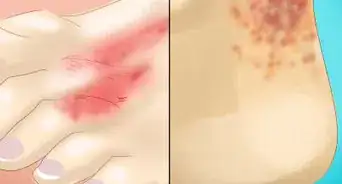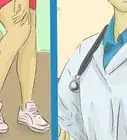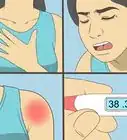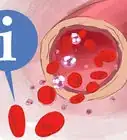This article was medically reviewed by Mark Ziats, MD, PhD. Dr. Mark Ziats is an Internal Medicine Physician, Scientist, Entrepreneur, and the Medical Director of xBiotech. With over five years of experience, he specializes in biotechnology, genomics, and medical devices. He earned a Doctor of Medicine degree from Baylor College of Medicine, a Ph.D. in Genetics from the University of Cambridge, and a BS in Biochemistry and Chemistry from Clemson University. He also completed the INNoVATE Program in Biotechnology Entrepreneurship at The Johns Hopkins University - Carey Business School. Dr. Ziats is board certified by the American Board of Internal Medicine.
There are 25 references cited in this article, which can be found at the bottom of the page.
This article has been viewed 33,604 times.
Sickle cell disease (SCD) is a genetic condition that is present at birth. It is inherited when a person receives two abnormal hemoglobin-Beta genes: one from each parent (a person may also be a carrier, in which he inherits one abnormal gene and one normal gene, and may exhibit mild symptoms). Sickle cell disease is the most common inherited blood disorder in the United States; approximately 100,000 Americans have the disease.[1] In people with sickle cell disease, abnormal hemoglobin molecules stick to one another and form long, rod-like structures. These structures cause red blood cells to become stiff, assuming a sickle shape. Their shape causes these red blood cells to pile up, causing blockages, and damaging vital organs and tissue, and impairs oxygen delivery to tissues.
Steps
Getting Diagnosed and Recognizing Common Early Symptoms
-
1Get tested. Sickle cell disease can be detected with a simple blood test, so if you think you may have the disease, see a doctor to get tested right away. In the United States, all newborns are required to be screened for sickle cell disease. This is because early treatment is very beneficial to patients.[2]
- It is also possible to do prenatal screening for sickle cell disease by testing fetal tissues that are collected by chorionic villus sampling or amniocentesis.[3]
-
2Look for swelling in the hands and feet. Swelling of the hands and feet, often called hand-foot disease, is often one of the first symptoms of sickle cell disease in babies. It occurs because the sickle-shaped blood cells are blocking the flow of blood, and it can be very painful.[4]
- If you or your baby experience hand-foot disease, see a doctor for treatment right away.
Advertisement -
3Watch out for changes in coloring. Sickle cell disease can cause the skin and whites of the eyes to develop a yellowish tint known as jaundice. Skin may also become abnormally pale.[5]
- See a doctor or go to the hospital if you or your baby has these symptoms.
- Jaundice is a result of the red blood cells getting broken down after they sickle, and the breakdown product of hemoglobin (called bilirubin) is a pigment that builds up in tissues of the body causing them to get yellow.
-
4Look for unexplained episodes of pain. People with sickle cell disease often experience "crises" or sudden episodes of pain. This happens when a blood cell becomes lodged in a blood vessel, and most frequently occurs in the chest, abdomen, and joints.[6]
- Crises are different for everyone; some people experience them rarely, while others have many crises each year. Some require hospitalization because their crises are severe, while others are less severe.
- Some people experience crises with no specific triggers, but for many people, crises can be brought on by stress, dehydration, altitude change, or temperature change and often by viral infection such as common flu.
- Some people with SCD also suffer from chronic pain, which may need to be managed with pain medications.[7]
-
5Watch out for symptoms of anemia. Many people who have sickle cell disease also have anemia because their body has a shortage of red blood cells, which are needed to supply oxygen to the body. While mild to moderate anemia is common, severe anemia can also develop suddenly and can be life-threatening, so see a doctor if your symptoms suddenly get worse.[8]
- Symptoms of anemia include fatigue, paleness, dizziness, and shortness of breath.
- Babies who are suffering from severe anemia may seem especially sluggish and uninterested in feeding.
-
6Be aware of fussiness in babies. Sickle cell disease can cause both fatigue and pain, so babies who are suffering from the disease may appear fussier than normal. Unfortunately, babies are not able to communicate their symptoms with us, but if you notice any unusual behavior, talk to your doctor about it as soon as possible.[9]
-
7Notice delayed growth. Children with sickle cell disease may grow and develop at a slower rate than children who do not have the disease. This is because oxygen is needed for growth, and people with sickle cell disease have fewer red blood cells to transport oxygen around the body. If your child seems to be growing slower than his peers or reaches puberty later, this may be due to sickle cell disease.[10]
Recognizing Common Serious Complications of SCD
-
1Watch out for infections. People with sickle cell disease, particularly infants and children, are at a higher risk for infections, and often from organisms that people with sickle cell disease do not typically get. Fever is often the first sign of a bacterial infection.
- See a doctor right away if you have sickle cell disease and have a fever of 101°F (38.3°C) or higher.[11]
- Common infections can be life-threatening to people with sickle cell disease, so treat them seriously.[12]
- You can prevent infections by washing your hands regularly, avoiding potentially contaminated food, and getting vaccinated against common infections like the flu and pneumonia.[13]
-
2Know the symptoms of acute chest syndrome. Acute chest syndrome is a serious medical condition that can affect people with sickle cell disease. Its symptoms are similar to those of pneumonia, including coughing, chest pain, labored breathing, and fever.[14]
- This is a life-threatening medical condition that requires immediate hospitalization. Treatment may include antibiotics, oxygen therapy, blood transfusions, and other medications.
-
3Recognize the symptoms of an aplastic crisis. An aplastic crisis occurs in patients with sickle cell disease when the bone marrow begins to produce fewer red blood cells, usually due to an infection. This can result in severe acute anemia, which is extremely serious.[15]
- Symptoms include paleness, extreme tiredness, and a rapid pulse. If you notice these symptoms, seek immediate medical treatment.
-
4Know the symptoms of splenic sequestration. Splenic sequestration is a complication of sickle cell disease that occurs when a large number of sickle cells get trapped in the spleen, causing it to suddenly enlarge. Symptoms include pale lips, sudden weakness, severe thirst, fast breathing, abdominal pain on the left side of body, and increased heart rate.[16]
- This condition is life-threatening, so treatment at a hospital is necessary. Treatment usually includes a blood transfusion.
- The spleen will be noticeably enlarged. If you or your child has sickle cell disease, you should regularly check the upper left part of the belly, just under the rib cage, for any signs of swelling. If you notice swelling, seek medical treatment right away.[17]
-
5Be aware of the symptoms of strokes. Strokes happen when the blood flow to the brain is restricted, so they are much more common in people who have sickle cell disease than in those who do not have the disease. Strokes can be debilitating and life-threatening, so it is important to call 911 as soon as you recognize the symptoms of a stroke, either in yourself or in a loved one.[18]
- Common signs of a stroke include difficulty talking, weakness on one side of the body, confusion, headache, and loss of balance.
- Silent strokes are typically asymptomatic, although they may still cause injury to the brain. If you or your child has problems learning, making decisions, or staying organized, it may be due to silents strokes, so see a doctor for testing.[19]
-
6Watch out for signs of deep vein thrombosis and pulmonary embolism. Deep vein thrombosis (DVT) and pulmonary embolism (PE) are conditions caused by blood clots that become lodged in the blood vessels. Both are very serious, so seek medical treatment right away if you experience symptoms of either.[20]
- Symptoms of deep vein thrombosis include swelling and pain in the leg.
- Symptoms of pulmonary embolism include shortness of breath, rapid heartbeat, coughing up blood, and dizziness.[21]
Recognizing Other Possible Complications of SCD
-
1Notice vision problems. Vision problems are fairly common in people with sickle cell disease because sickle-shaped cells can damage blood vessels in the retina. If you start experiencing a change in your vision, see an eye doctor as soon as possible.[22]
- Have your eyes tested once a year to check for damage caused by sickle cell disease.
-
2Watch for leg ulcers. Some people with sickle cell disease, typically men, develop ulcers, or open sores, on the lower halves of their legs.[23]
- Most often, ulcers can be treated at home with antibiotic ointment. Elevating the legs may also help.
- You may not need medical treatment for every ulcer, but you should see a doctor if you develop them frequently or if they do not heal. Skin grafts may be necessary in severe cases.
-
3Be aware of heart symptoms. There are a variety of heart problems that can be caused by sickle cell disease. The cells can damage the blood vessels to the heart, which can interfere with its ability to function normally. Enlarged heart and pulmonary hypertension are also common heart conditions in people with sickle cell disease.[24]
- Your doctor should monitor you for heart problems. Be sure to always report any symptoms you have, including fatigue, shortness of breath, and chest pain.
- People who have had multiple blood transfusions are at an increased risk of developing heart problems due to the possibility of an iron overload.
-
4Be aware of liver symptoms. Liver damage can occur if sickle cells get trapped in the liver tissue. Liver problems can also be caused by iron overload, which is a risk of blood transfusions.[25]
- Symptoms of severe liver problems include jaundice, fatigue, itching, and abdominal pain.[26]
- Liver complications in patients with sickle cell disease often occur suddenly.
-
5Be aware of kidney symptoms. Sickle cell disease often causes the kidneys to have difficulty concentrating urine. The disease can also lead to kidney failure.[27]
- Common symptoms include frequent urination, incontinence, bed wetting, and blood in the urine.
-
6Be aware of lung symptoms. People with sickle cell disease are prone to lung problems because the blood vessels that supply blood to the lungs can be damaged, which makes it difficult for the heart to supply them with oxygen-rich blood. This often leads to a conditions called pulmonary hypertension, an increase in pressure in the blood vessels in the lungs, which can be very serious.[28]
- Fatigue and shortness of breath are the most common symptoms of pulmonary hypertension. Another common symptom is swelling in the legs, which is caused by backup of the right side of the heart, secondary to the lung hypertension.
-
7Know the symptoms of gallstones. Gallstones are a common complication of sickle cell disease because the disease causes a substance called bilirubin to get stuck in the gallbladder, which causes stones to form (in those who do not have SCA, gallstones are usually caused by an accumulation of fat). People who get gallstones may have them recur after they have been removed by doctors.[29]
- The most common symptoms of gallstones are nausea, vomiting, and pain in the upper right section of the belly.
- In serious cases, the gallbladder may need to be removed to manage symptoms.
-
8Watch for joint symptoms. Sickle cell disease sometimes attacks the body's joints, including the shoulders, knees, elbows, and hips. This results in pain whenever the joint is moved.[30]
- In severe cases, patients may need joint replacement surgery in order to regain function.
-
9Recognize priapism. Male patients with sickle cell disease sometimes experience priapism, which is a painful, prolonged erection of the penis. This sometimes goes away on its own, but sometimes requires medical treatment.[31]
- Get medical attention if an episode of priapism lasts for longer than four hours. If left untreated, it may lead to impotence.
Expert Q&A
-
QuestionCan a person with sickle cell grow tall during puberty?
 Mark Ziats, MD, PhDDr. Mark Ziats is an Internal Medicine Physician, Scientist, Entrepreneur, and the Medical Director of xBiotech. With over five years of experience, he specializes in biotechnology, genomics, and medical devices. He earned a Doctor of Medicine degree from Baylor College of Medicine, a Ph.D. in Genetics from the University of Cambridge, and a BS in Biochemistry and Chemistry from Clemson University. He also completed the INNoVATE Program in Biotechnology Entrepreneurship at The Johns Hopkins University - Carey Business School. Dr. Ziats is board certified by the American Board of Internal Medicine.
Mark Ziats, MD, PhDDr. Mark Ziats is an Internal Medicine Physician, Scientist, Entrepreneur, and the Medical Director of xBiotech. With over five years of experience, he specializes in biotechnology, genomics, and medical devices. He earned a Doctor of Medicine degree from Baylor College of Medicine, a Ph.D. in Genetics from the University of Cambridge, and a BS in Biochemistry and Chemistry from Clemson University. He also completed the INNoVATE Program in Biotechnology Entrepreneurship at The Johns Hopkins University - Carey Business School. Dr. Ziats is board certified by the American Board of Internal Medicine.
Internal Medicine Physician Yes. It is important they are regularly seen by a doctor to manage their SCD appropriately so that they avoid having low oxygen as a child, which would predispose them to growth retardation.
Yes. It is important they are regularly seen by a doctor to manage their SCD appropriately so that they avoid having low oxygen as a child, which would predispose them to growth retardation.
Warnings
- B sure to mention all of your symptoms to your doctor right away.⧼thumbs_response⧽
- Women with sickle cell disease are more likely to have problems during pregnancy that can affect their health and the health of their unborn baby.[32]⧼thumbs_response⧽
References
- ↑ https://www.genome.gov/10001219/learning-about-sickle-cell-disease/
- ↑ http://www.nhlbi.nih.gov/health/health-topics/topics/sca/signs
- ↑ https://www.nhs.uk/pregnancy/your-pregnancy-care/screening-for-sickle-cell-and-thalassaemia/
- ↑ https://my.clevelandclinic.org/health/diseases/4579-sickle-cell-anemia
- ↑ https://kidshealth.org/en/teens/sickle-cell-anemia.html
- ↑ https://my.clevelandclinic.org/health/diseases/4579-sickle-cell-anemia
- ↑ http://www.nhlbi.nih.gov/health/health-topics/topics/sca/signs
- ↑ https://www.hopkinsmedicine.org/health/conditions-and-diseases/sickle-cell-disease
- ↑ https://medlineplus.gov/sicklecelldisease.html
- ↑ https://kidshealth.org/en/parents/sickle-cell-anemia.html
- ↑ http://kidshealth.org/en/parents/sickle-cell-anemia.html#
- ↑ http://patient.info/health/sickle-cell-disease-and-sickle-cell-anaemia-leaflet
- ↑ http://www.cdc.gov/ncbddd/sicklecell/treatments.html
- ↑ https://www.cdc.gov/ncbddd/sicklecell/treatments.html#Acute
- ↑ https://www.uofmhealth.org/health-library/hw253985
- ↑ https://www.cdc.gov/ncbddd/sicklecell/treatments.html#Splenic
- ↑ https://www.hopkinsmedicine.org/health/conditions-and-diseases/sickle-cell-disease
- ↑ https://kidshealth.org/en/parents/sickle-cell-anemia.html
- ↑ http://www.nhlbi.nih.gov/health/health-topics/topics/sca/treatment#eyes
- ↑ https://www.cdc.gov/ncbddd/sicklecell/treatments.html#dvt
- ↑ https://www.hopkinsmedicine.org/health/conditions-and-diseases/pulmonary-embolism
- ↑ https://www.uofmhealth.org/health-library/hw253469
- ↑ https://www.hopkinsmedicine.org/health/conditions-and-diseases/sickle-cell-disease
- ↑ https://www.upmc.com/services/pulmonology/conditions/sickle-cell-disease
- ↑ http://www.nhlbi.nih.gov/health/health-topics/topics/sca/signs
- ↑ http://www.cochrane.org/CD010985/CF_interventions-for-treating-intrahepatic-cholestasis-in-people-with-sickle-cell-disease
- ↑ https://www.cdc.gov/ncbddd/sicklecell/betterhealthtoolkit/kidney-health.html
- ↑ https://www.ncbi.nlm.nih.gov/pmc/articles/PMC3373067/
- ↑ https://www.niddk.nih.gov/health-information/digestive-diseases/gallstones/symptoms-causes
- ↑ https://pubmed.ncbi.nlm.nih.gov/16214653/
- ↑ http://www.cdc.gov/ncbddd/sicklecell/treatments.html
- ↑ https://www.urmc.rochester.edu/encyclopedia/content.aspx?ContentTypeID=90&ContentID=P02499
-Step-1.webp)
-Step-2.webp)
-Step-3.webp)
-Step-4.webp)
-Step-5.webp)
-Step-6.webp)
-Step-7.webp)
-Step-8.webp)
-Step-9.webp)
-Step-10.webp)
-Step-11.webp)
-Step-12.webp)
-Step-13.webp)
-Step-14.webp)
-Step-15.webp)
-Step-16.webp)
-Step-17.webp)
-Step-18.webp)
-Step-19.webp)
-Step-20.webp)
-Step-21.webp)
-Step-22.webp)
























































Medical Disclaimer
The content of this article is not intended to be a substitute for professional medical advice, examination, diagnosis, or treatment. You should always contact your doctor or other qualified healthcare professional before starting, changing, or stopping any kind of health treatment.
Read More...